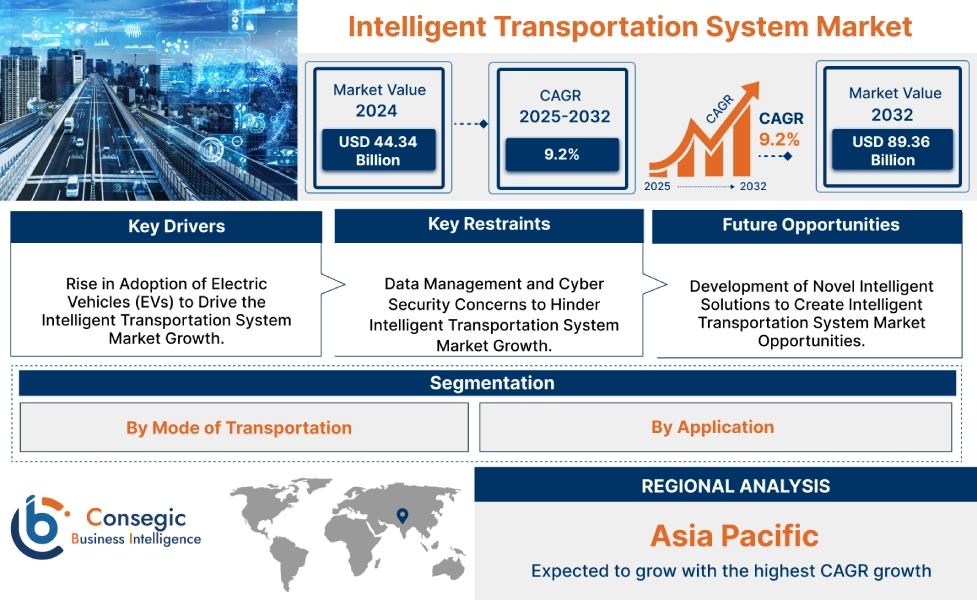Intelligent Transportation System Market Size:
The Intelligent Transportation System Market size is growing with a CAGR of 9.2% during the forecast period (2025-2032), and the market is projected to be valued at USD 89.36 Billion by 2032 from USD 44.34 Billion in 2024. Additionally, the market value for 2025 is attributed to USD 48.26 Billion.
Intelligent Transportation System Market Scope & Overview:
An Intelligent Transportation System (ITS) is a complete framework that uses advanced information and communication technologies, such as ICT, in transportation infrastructure and vehicles to enhance safety, efficiency, and sustainability. By collecting and analyzing real-time data from numerous sources such as sensors, cameras, GPS, and communication networks, ITS provides actionable insights to drivers, commuters, and traffic managers. This allows for dynamic adjustments to traffic signals, real-time routing recommendations, incident detection, and improved public transit management, ultimately aiming to reduce congestion, minimize environmental impact, and make transportation networks smarter and more responsive.
Intelligent Transportation System Market Dynamics - (DRO) :
Key Drivers:
Rise in Adoption of Electric Vehicles (EVs) to Drive the Intelligent Transportation System Market Growth.
As EVs become more prevalent on roads, the existing transportation infrastructure faces new demands related to charging management, grid stability, and efficient traffic flow. This leads to the adoption of intelligent systems that are essential for optimizing traffic management to reduce congestion, providing smart charging infrastructure assistance, facilitating seamless integration with smart grids, and enhancing overall road safety and efficiency within an electrified mobility ecosystem. The rise in the adoption of electric vehicles is influencing the growth of these systems.
For instance,
- According to the data published by the International Energy Agency in 2023, the electric vehicle (EV) is accelerating, with global sales surging to nearly 14 million units in 2023. The electric car sales were 3.5 million higher than in 2023.
Thus, the rise in the adoption of electric vehicles is propelling the Intelligent Transportation System Market demand.
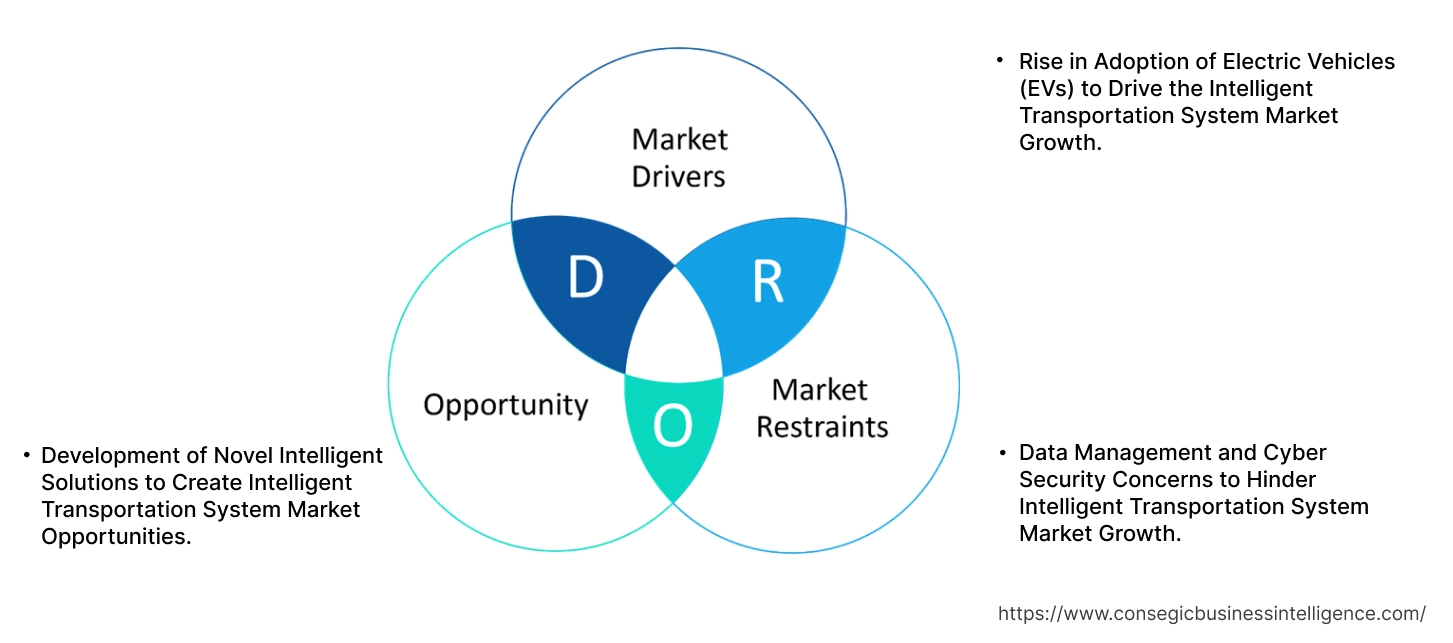
Key Restraints:
Data Management and Cyber Security Concerns to Hinder Intelligent Transportation System Market Growth.
The widespread adoption of intelligent transportation systems focuses on the collection, processing, and exchange of vast amounts of sensitive data. The volume, velocity, and variety of data generated by connected vehicles, smart infrastructure, and traffic sensors present hurdles in terms of storage, analysis, and real-time processing, mainly requiring substantial investment in advanced analytics and cloud infrastructure. Additionally, the interconnected nature of this system makes it a major target for cyberattacks, ranging from data breaches and ransomware to denial-of-service attacks and spoofing, which compromises passenger safety, disrupt critical transportation services, or steals sensitive personal information. Therefore, the above-mentioned factors are contributing to the hindrance in market growth.
Future Opportunities :
Development of Novel Intelligent Solutions to Create Intelligent Transportation System Market Opportunities.
The novel intelligent solutions, leveraging novel technologies like Artificial Intelligence (AI), the Internet of Things (IoT), 5G connectivity, and big data analytics, are enhancing the intelligent transportation system properties. These innovations are transforming traditional transportation infrastructure into smart, interconnected networks capable of real-time data collection, analysis, and autonomous decision-making. By using AI-powered traffic management systems, predictive analytics for congestion forecasting, and intelligent parking solutions, cities and transportation agencies optimize traffic flow, reduce accidents, enhance public transit efficiency, and minimize environmental impact. Various manufacturers are focusing on developing novel intelligent systems.
For instance,
- In 2024, Huawei introduced the Smart Railway Perimeter Detection Solution. It provides multi-dimensional sensing, multi-technology convergence, and AI to precisely detect abnormal intrusions across many scenarios in any weather, improving inspection efficiency by 50% and safeguarding railway assets and operations.
Thus, due to the aforementioned factors, increasing focus on the development of novel systems creates Intelligent Transportation System market opportunities.
Intelligent Transportation System Market Segmental Analysis :
By Mode of Transportation:
Based on the Mode of Transportation, the market is categorized into roadway, railway, airways, and marine.
Trends in the Mode of Transportation:
- Roadways are experiencing a dominant trend towards becoming smart environments by integrating advanced technologies like AI-powered analytics and connected vehicle systems to optimize traffic flow, enhance safety, and improve overall efficiency.
- The railway segment is experiencing rapid growth driven by the increasing integration of advanced technologies like IoT sensors, AI-powered predictive maintenance, and 5G connectivity to enhance efficiency, safety, and the overall passenger experience.
The roadway segment accounted for the largest Intelligent Transportation System market share of 40.11% in 2024.
- Roadways serve as a primary mode of transportation, forming the foundational infrastructure upon which intelligent transportation systems are built to enhance efficiency, safety, and sustainability.
- Roadways are transformed into smart environments through the integration of various technologies, including sensors, communication networks, and data analytics platforms.
- Manufacturers are introducing novel intelligent solutions for enhancing traffic efficiency.
- For instance, in 2024, Huawei introduced a novel Intelligent Transportation System 2.0 Solution for the road sector. It consists of software-defined cameras (SDCs), radar-integrated cameras, edge computing, cloud, big data, and other advanced technologies to intelligently detect traffic incidents, optimize signal control, and monitor and analyze traffic situations, resulting in 15% higher overall traffic efficiency.
- Thus, the aforementioned factors are driving the demand for the segment.
The railway segment is expected to grow at the fastest CAGR over the forecast period.
- Railways play a crucial and rapidly expanding role, driven by the increasing need for efficient, safe, and sustainable mass transit solutions.
- ITS in railways encompasses a wide array of advanced technologies like IoT sensors for real-time track & train monitoring, AI-powered predictive maintenance, smart signaling systems, and sophisticated communication networks including 5G to optimize train operations, enhance safety by preventing accidents, and improve the overall passenger experience through real-time information, smart ticketing, and enhanced security surveillance.
- As a result, based on the market analysis, owing to the aforementioned factors, the railway segment is expected to be lucrative over the forecast period.
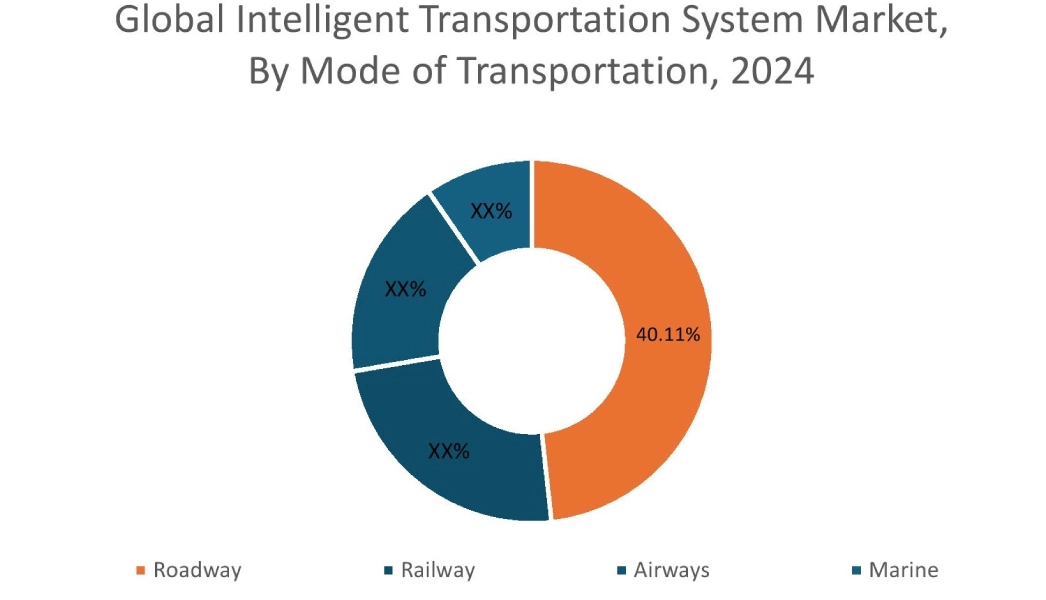
By Application:
Based on the application, the market is categorized into traffic management, road safety & security, freight management, public transport, parking management, and others.
Trends in the Application:
- The adoption of the smart traffic management systems trend is being driven by the integration of AI, IoT, and real-time data analytics, leading to dynamic adjustments for congestion reduction, enhanced safety, and overall urban mobility optimization.
- The freight management segment trend is influenced by the integration of real-time tracking, dynamic route optimization, predictive analytics, and automation, which significantly enhance visibility and efficiency.
The traffic management segment accounted for the largest Intelligent Transportation System market share in 2024.
- Traffic management stands as an important application in the market, leveraging advanced technologies to improve congestion, enhance safety, and optimize overall urban mobility.
- By integrating sensors, cameras, communication networks, and data analytics, ITS solutions provide real-time insights into traffic conditions, allowing dynamic adjustments to traffic signals, variable message signs, and even route guidance systems.
- Various governments are introducing novel traffic management systems to improve road safety.
- For instance, in 2022, Kapsch TrafficCom AG reported that the Intelligent Corridor at Nicholson Street, Carlton, will be launched by the University of Melbourne, the Austrian technology firm Kapsch TrafficCom, and the Victorian Department of Transport. Covering a 2.5 kilometer stretch of Nicholson Street between Alexandra and Victoria Parades, the Intelligent Corridor will use sensors, cloud-based AI, machine learning algorithms, predictive models, and real-time data capture to improve traffic management.
- Thus, as per the Intelligent Transportation System market analysis, the adoption of smart traffic management systems is driving the segment share.
The freight management segment is expected to grow at the fastest CAGR over the forecast period.
- Freight management involves real-time tracking of shipments, dynamic route optimization based on traffic and weather conditions, predictive analytics for anticipating delays, and automated processes for tasks such as scheduling, documentation, and regulatory compliance.
- By enhancing visibility, efficiency, and communication among all stakeholders, ITS in freight management significantly reduces operational costs, minimizes transit times, improves delivery reliability, and contributes to environmental sustainability through optimized fuel consumption and reduced emissions, ultimately revolutionizing logistics and international trade dynamics.
- As a result, owing to the aforementioned factors, the freight management segment is expected to show lucrative trends over the forecast period.
Regional Analysis:
The regional segment includes North America, Europe, Asia Pacific, the Middle East and Africa, and Latin America.
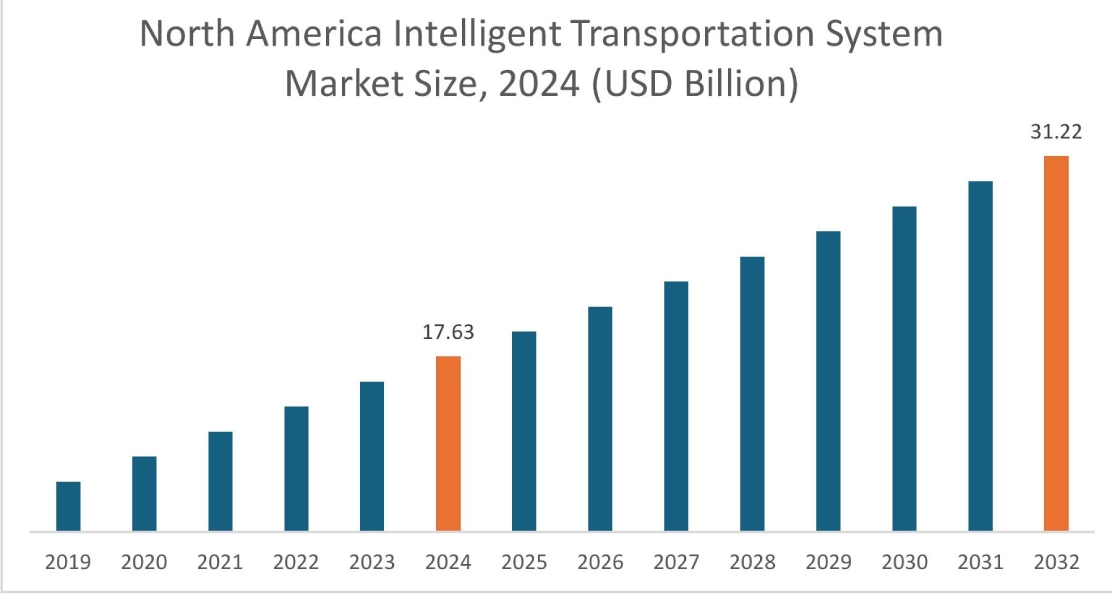
In 2024, North America accounted for the highest market share at 39.77% and was valued at USD 17.63 Billion and is expected to reach USD 31.22 Billion in 2032. In North America, the U.S. accounted for the market share of 73.88% during the base year of 2024. The North America region is targeting zero-emission vehicle sales, supported by expanding public charging infrastructure. This ongoing transition is increasingly intertwined with the development and deployment of intelligent transportation systems. These systems play a crucial role in managing the growing EV fleet by optimizing traffic flow, reducing congestion, and providing dynamic information for route planning and charging station availability. The rise in the adoption of electric vehicles is influencing the use of these systems.
For instance,
- The data by Argonne National Laboratory states that in the U.S., electric vehicle (EV) sales are increasing, with over 1.5 million plug-in electric vehicles (PEVs) sold in 2024, a 7% increase from 2023.
Thus, as per the market analysis, the rise in the adoption of electric vehicles is influencing the intelligent transportation system market expansion.
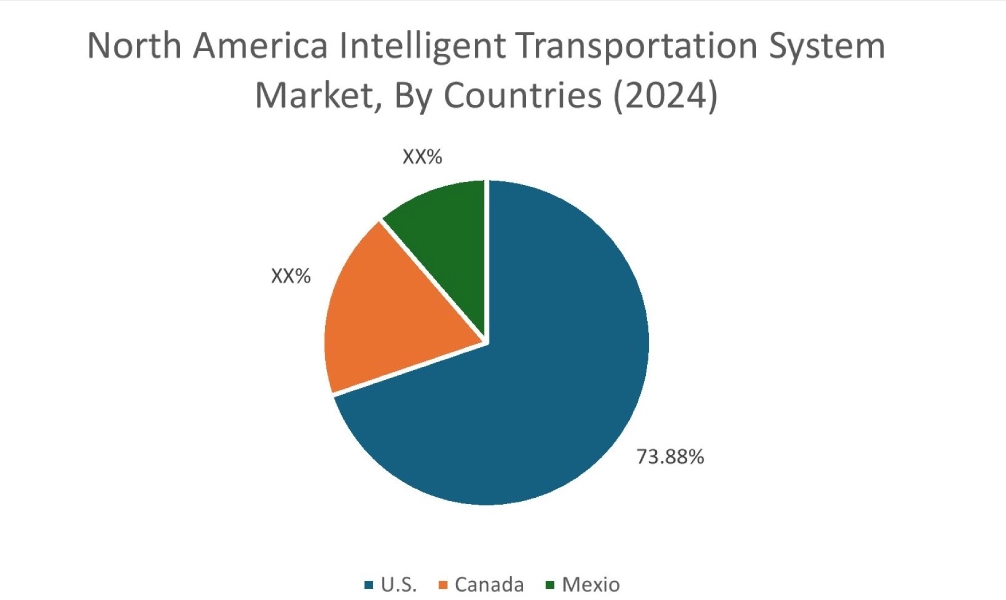
In Asia Pacific, the intelligent transportation system industry is experiencing the fastest growth with a CAGR of 12.1% over the forecast period. The Asia Pacific region is rapidly becoming a significant region in the development of novel intelligent system solutions, driven by rapid urbanization, increasing traffic congestion, and a strong push for smart city initiatives. This involves the integration of novel technologies like AI, IoT, 5G connectivity, and big data analytics. Countries like China, Japan, and South Korea are implementing advanced traffic management systems that use AI to predict traffic patterns and dynamically adjust signals, smart parking solutions, and real-time passenger information systems. Thus, as per the market analysis, the above-mentioned factors are contributing to the intelligent transportation system market trends in this region.
Roadway transportation remains a significant mode of transportation for the intelligent transportation system market in Europe, consistently holding a large share due to the region's extensive road network and heavy reliance on road-based passenger and freight movement. The continuous increase in traffic congestion, coupled with rising concerns about road safety and environmental impact, are key driver for the adoption of ITS solutions within the roadway segment. European governments and transportation authorities are actively investing in intelligent traffic management systems, advanced travel information systems, smart highway infrastructure, and vehicle-to-everything communication technologies to optimize traffic flow, reduce emissions, enhance road safety, and improve overall mobility. This has a positive impact on the intelligent transportation system market demand.
Parking management, as a crucial application of intelligent transportation systems, is gaining significant growth in Latin America. With rapid urbanization, increasing vehicle ownership, and persistent traffic congestion in major cities, there is a rise in demand for efficient parking solutions. ITS-driven parking management systems leverage technologies such as IoT sensors, real-time data analytics, mobile applications, and license plate recognition (LPR) to guide drivers to available parking spaces, reduce circling time, and optimize space utilization. This not only alleviates traffic congestion and reduces harmful emissions but also enhances the overall urban mobility experience. Thus, as per the intelligent transportation system market analysis, the aforementioned factors are contributing to the intelligent transportation system market trends in the region.
Railway transportation is playing an increasingly vital role in the market across the Middle East and Africa region, driven by various government initiatives to diversify economies, improve connectivity, and enhance urban mobility. Countries in this region are heavily investing in modernizing and expanding their railway networks, including high-speed passenger lines and dedicated freight corridors. This development necessitates the integration of advanced ITS solutions for efficient traffic management, real-time passenger information systems, smart ticketing, and others. Thus, based on the market analysis, the aforementioned factors are contributing to the intelligent transportation system market expansion in this region.
Top Key Players and Market Share Insights:
The Global Intelligent Transportation System Market is highly competitive, with major players providing products to the national and international markets. Key players are adopting several strategies in research and development (R&D) and product innovation to hold a strong position in the global Intelligent Transportation System market. Key players in the Intelligent Transportation System industry include
- GMV Innovating Solutions S.L. (Madrid)
- Hitachi Ltd. (Tokyo)
- Indra Sistemas, S.A. (Spain)
- NEC Corporation (Japan)
- TomTom International BV (Netherlands)
- Siemens (Germany)
- Cubic Corporation (U.S.)
- Kapsch TrafficCom AG (Austria)
- Conduent Incorporated (U.S.)
- DENSO Corporation (Japan)
Intelligent Transportation System Market Report Insights :
| Report Attributes | Report Details |
| Study Timeline | 2019-2032 |
| Market Size in 2032 | USD 89.36 Billion |
| CAGR (2025-2032) | 9.2% |
| By Mode of Transportation |
|
| By Application |
|
| By Region |
|
| Key Players |
|
| North America | U.S. Canada Mexico |
| Europe | U.K. Germany France Spain Italy Russia Benelux Rest of Europe |
| APAC | China South Korea Japan India Australia ASEAN Rest of Asia-Pacific |
| Middle East and Africa | GCC Turkey South Africa Rest of MEA |
| LATAM | Brazil Argentina Chile Rest of LATAM |
| Report Coverage |
|
;
Key Questions Answered in the Report
How big is the Intelligent Transportation System market? +
In 2024, the Intelligent Transportation System market is USD 44.34 Billion.
Which is the fastest-growing region in the Intelligent Transportation System market? +
Asia Pacific is the fastest-growing region in the Intelligent Transportation System market.
What specific segmentation details are covered in the Intelligent Transportation System market? +
By Mode of Transportation, and By Application segmentation details are covered in the Intelligent Transportation System market.
Who are the major players in the Intelligent Transportation System market? +
GMV Innovating Solutions S.L. (Madrid), Hitachi Ltd. (Tokyo), and Siemens (Germany) are some of the major players in the market.
